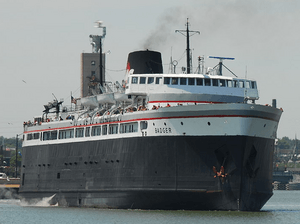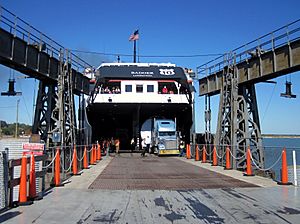SS Badger facts for kids
 |
|
Quick facts for kids History |
|
|---|---|
| Name | SS Badger |
| Namesake | University of Wisconsin Badgers |
| Owner | Interlake Steamship Company |
| Route | |
| Builder | Christy Corporation, Sturgeon Bay, Wisconsin |
| Yard number | Hull No. 370 |
| Launched | September 6, 1952 |
| Sponsored by | Mrs. Walter J. Kohler (wife of Governor of Wisconsin) |
| In service | March 21, 1953 |
| Homeport | Ludington, MI |
| Identification |
|
| Nickname(s) | "The Big Badger" (Charles F. Conrad's favorite description) |
| Status | Active |
| General characteristics | |
| Type | Passenger and automobile car ferry |
| Tonnage | 4,244 gross tons |
| Displacement | 6,650 tons |
| Length | 410 ft 6 in (125.12 m) |
| Beam | 59 ft 6 in (18.14 m) |
| Height | 106 ft 9 in (32.54 m) |
| Depth | 24 ft (7.32 m) molded depth |
| Decks | 2 passenger, 1 vehicle |
| Installed power | Steam, coal-fired |
| Propulsion | Two four-cylinder compound Skinner Unaflow steam engines, totaling 7,000 shp (5.22 MW); four Foster-Wheeler water-tube type D boilers, 470 psi (3.24 MPa) |
| Speed |
|
| Capacity | 620 passengers, 180 automobiles, also tour buses, RVs, motorcycles, and commercial trucks |
| Crew | 50–60 |
|
SS Badger
|
|
| Location | 700 S. William Street, Ludington, Michigan |
| NRHP reference No. | 09000679 |
| Significant dates | |
| Added to NRHP | December 11, 2009 |
| Designated NHL | January 20, 2016 |
The SS Badger is a special ferry that carries both people and vehicles across Lake Michigan. It has been sailing since 1953. This ship travels between Ludington, Michigan, and Manitowoc, Wisconsin. This trip is about 62 miles (100 km) long. It helps connect U.S. Highway 10 (US 10) between these two cities.
The Badger is the last large ship on the Great Lakes that still uses coal for power. Because of its history, it was named a National Historic Landmark on January 20, 2016. The ship is named after the University of Wisconsin's sports teams, the Wisconsin Badgers. The Badger runs from May to October each year.
Contents
History of the SS Badger
The Badger was built in 1952 by the Christy Corporation in Sturgeon Bay, Wisconsin. It was made as a rail car ferry, meaning it could carry railroad cars. It also carried passengers and cars. The Badger has a strong hull, which helps it break through ice. It has a twin ship called the SS Spartan.
Early Years and Service Changes
The SS Badger started service on March 21, 1953. It was first owned by the Chesapeake and Ohio Railway. This company had bought the ferry operations in Ludington in 1947. After 1972, fewer trips were made. Most of the older ships were retired. Trips to Milwaukee, Wisconsin, and Manitowoc, Wisconsin, stopped. Only the route between Ludington and Kewaunee, Wisconsin, remained.
On July 1, 1983, the company sold the Badger and two other ships. These were the Spartan and the City of Midland 41. Glen F. Bowden bought them and started a new company. This company was called the Michigan–Wisconsin Transportation Company (MWT). It kept the ferry service going.
Challenges and New Ownership
In the 1980s, the idea of carrying railroad cars across Lake Michigan faced money problems. By November 1988, the Badger was the only ship still running. It was the last of 14 ferries that used to sail from Ludington. On November 16, 1990, the company faced bankruptcy. Bowden stopped the Badger from running. This ended 93 years of railroad car ferry service from Ludington. It also ended 98 years of this service on Lake Michigan.
In December 2020, the Badger was sold again. The Interlake Steamship Company bought it. This sale also included the City of Midland 41 and the SS Spartan. Interlake is based in Middleburg Heights, Ohio.
Lake Michigan Carferry Service
After being out of service for a year, a man named Charles F. Conrad bought the three ferries. He was from Ludington. He worked hard to fix up the Badger. He changed it to carry only passengers and cars. The Badger is now the only ferry of its kind still running in the world. It is a symbol of car ferry history on the Great Lakes.
Conrad stopped being president of Lake Michigan Carferry Service in 1993. He passed away in 1995. Since 1993, his son-in-law, Robert Manglitz, has led the company.
Unique Features of the Badger
The Badger is special because it is the last big ship in the United States that burns coal for power. It is also the last ship on the Great Lakes to use Skinner Unaflow engines. These engines were made in Erie, Pennsylvania.
A trip across Lake Michigan on the Badger takes about four hours. It covers about 60 miles (97 km). The SS Badger almost never misses a trip because of bad weather.
Historical Recognition
The SS Badger is a registered historical site in two states. Both the Michigan Historical Commission and the Wisconsin Historical Commission named it a historical site in 1997. In 1996, the Badger's engine system was recognized as an important mechanical engineering landmark. This was done by the American Society of Mechanical Engineers. In 2002, the Badger was named Ship of the Year. It was added to the National Register of Historic Places on December 11, 2009. On January 20, 2016, the National Park Service named the ship a National Historic Landmark.
Recent Events and Cargo
On August 9, 2008, the Badger had a problem with a part called a stern bearing. This caused the company to cancel trips for almost a week. It was the first time this specific problem had happened. The ferry sailed to a shipyard in Sturgeon Bay, Wisconsin, for repairs. Divers from California helped fix it. Regular trips started again on August 15, 2008.
The Badger's large deck can carry tractor trailers and other big commercial loads. In 2012, it carried over 1,000 commercial loads. The ship also carries parts for wind turbines from Wisconsin. Some of these parts are 150 feet (45.7 m) long and weigh 150,000 pounds (68,000 kg). In 2015, the ferry officially became part of US 10. This helped connect the two parts of the highway that were separated by the lake.
Environmental Impact and Solutions
In late 2008, the SS Badger faced criticism from the Environmental Protection Agency (EPA). This was because it used to dump untreated coal ash into Lake Michigan. Burning 55 short tons (49 long tons; 50 t) of coal each day created 4 short tons (3.57 long tons; 3.63 t) of ash. Coal ash is a leftover product from the Badger's engine system.
The Badger had already been looked at by the EPA for air pollution. But it was allowed to continue operating as a coal-fired ship because of its historical importance. Company officials said coal ash was like "harmless sand." They wanted to keep the Badger running on coal. The company looked into ways to reduce its impact on the lake. One idea was to store the ash on the ship and unload it in Ludington. Another idea was to use natural gas. This would keep the historical boiler system but make the ship more environmentally friendly.
In March 2013, Lake Michigan Carferry agreed with the United States Department of Justice and the EPA to stop dumping ash. They would use a new system to hold the ash on board. This system was installed. In January 2015, work began on a conveyor system. This system stores ash in four bins on the ship. A new control system helps the ship burn less coal and make less ash. The Badger was changed so it no longer puts ash into the lake. The ash is now taken off the ship and used to make cement.
In November 2015, the Badger went to Wisconsin for regular check-ups. This included checking the hull and cleaning the bottom and propellers.



